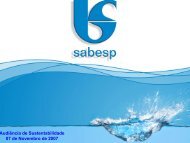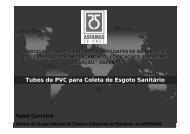Sustainability r e p o r t - Sabesp
Sustainability r e p o r t - Sabesp
Sustainability r e p o r t - Sabesp
You also want an ePaper? Increase the reach of your titles
YUMPU automatically turns print PDFs into web optimized ePapers that Google loves.
Table 30: LA7 Rates of injury, occupational diseases, lost days, andabsenteeism, and number of work-related fatalities by regionOccupational safety andhealth indicators byregionRMSP Inland and coast Total - <strong>Sabesp</strong>2008 2009 2008 2009 2008 2009Frequency rate (TF) 6.44 4.77 8.30 5.38 7.20 5.04Severity Rate (TG) 217 414 279 220 242 230Days lost and deducted 3,766 6,764 3,534 2,656 7,300 9,423Occupational disease 0 1 4 0 4 1Absenteeism 5.3% 4.7% 6.4% 6.1% 5.7% 5.3Deaths in general 16 24 15 18 31 42Work-related deaths 0 0 0 0 0 0The Safety and Health Policy was revised in 2009 and we intensified the application ofthe risk analysis methodology, based on the current OHSAS 18001:2007 standard, within-class training and distance learning (EAD), and the enhancement of the environmentalrisk prevention programs (PPRA).Construction of the Itaquera water lift station.Occupational safety and healthPR1 The Occupational Safety and Health Policy, revised in 2009, sets out theguidelines, concepts, and responsibilities to preserve and protect the life and goodhealth of employees, apprentices, interns, visitors, service providers, and also theenvironment.The guidelines that steer u safety policy are as follows: responsibility for thesafety of everyone; performance related to safety and health always coupledwith and enhanced by the development of all processes; work facilities andenvironments, including of service providers, to protect their health; and comfortand efficient performance.The number of occupational accidents resulting in leave of absence dropped by33 percent as compared to 2008, as a result of the development of severaleducational and prevention programs that embed the values of a safety andworking conditions improvement culture.In complement of awareness building among employees and service providers, we haveimplemented and applying the Prevention Minute since 2003, which permits a briefdiscussion of occupational safety and health issues arising from dailyaffairs. We disclosed more than 35 topics on work accident prevention,with 20,536 participations by our employees. Safety in activitiesinvolving severe accidents is discussed in structured routine meetings.Dengue prevention is being covered every year for the elimination of mosquitobreeding places and general guidance on the disease and required care. We are partof the State Committee against Dengue, coordinated by the Endemic Diseases ControlSuperintendency (SUCEN). During the H1N1 flu outbreak, we maintained educationalactions on hygiene and containment, according to the recommendation of the publichealth agencies.LA6 Ergonomics was a mandatory topic in all the 52 Sipat (Internal Work AccidentPrevention Week), which was attended by 17,000 people. This preventive event is heldin the entire Company in August and is a way to value the safety and health actions. Itsorganization involves the 180 CIPAs (Internal Accident Prevention Committees) and their1,350 members. To respond to potential emergency situations, we have 300 EmergencyBrigades, gathering 2,400 trained employee. We periodically conduct emergency drillsat our facilities. In 2009, 700 members of the brigades attended review courses. Wepurchased defibrillators for both administration complexes in the state capital. Wecreated the Brigade Committee, with representatives for the entire Company, whichSafety is discussed instructured, routine meetingsat the company134 Relatório de Sustentabilidade 2009 135





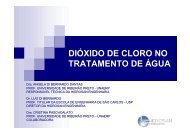

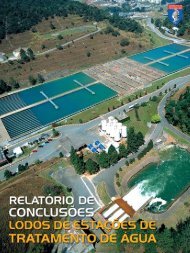
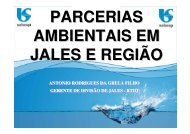
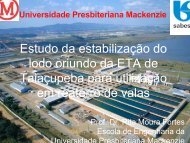
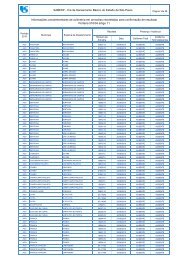
![MBBR ppt for Pulp&Paper, Sabesp, Oct 3, 2008 [Somente leitura]](https://img.yumpu.com/34976291/1/190x135/mbbr-ppt-for-pulppaper-sabesp-oct-3-2008-somente-leitura.jpg?quality=85)
